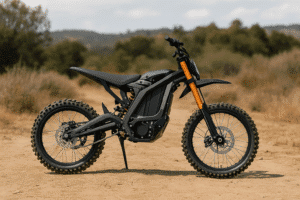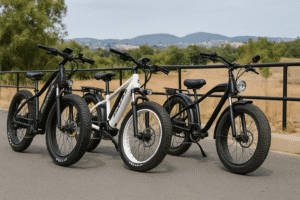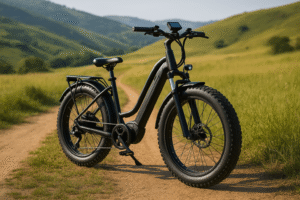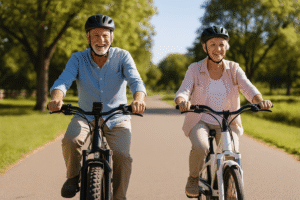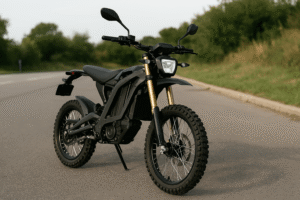Want to know how to make an electric bike go faster? This step-by-step guide breaks down the most effective ways to increase speed, legally and safely.
Whether you’re looking to upgrade your motor, tweak your settings, or reduce drag, we’ll show you exactly what works and what to watch out for.
TL;DR
You can make your e-bike go faster by upgrading the motor or battery, adjusting controller settings, reducing weight, increasing tire pressure, improving aerodynamics, or changing gear ratios. Each method comes with different speed gains and legal risks.
E-Bike Speed Upgrade Methods Compared
Here’s a quick comparison of popular ways to make your electric bike go faster, including how much speed gain to expect, the risks involved, and whether the method is legal.
| Method | Speed Impact | Risk Level | Legal? |
| Upgrade motor | High | Moderate | Sometimes illegal |
| Increase battery voltage | Medium–High | Moderate | Legal if supported |
| Adjust controller | Medium | High (if tampered) | May void warranty |
| Reduce weight | Low–Medium | Low | Yes |
| Inflate tires properly | Low | None | Yes |
| Improve aerodynamics | Low | None | Yes |
| Modify gear ratio | Medium | Low | Yes |
| Use tuning kit | High | High | Often illegal |
How Fast Can an E-Bike Legally Go?
Most e-bikes have a legal speed limit of 20 to 28 mph (32 to 45 km/h), depending on where you live. In the U.S., Class 1 and Class 2 e-bikes max out at 20 mph, while Class 3 e-bikes can reach 28 mph but only with pedal assist. In many parts of Europe and the UK, e-bikes are limited to 15.5 mph (25 km/h).
Why the restrictions? Safety and regulations. Once an e-bike goes beyond these speeds, it’s no longer considered a bicycle—it’s more like a motorbike, which means extra rules like licensing, insurance, and registration.
If you’re planning to tweak your e-bike for more speed, make sure you’re aware of the laws in your area to avoid fines or restrictions.
Read more:
How to Make an Electric Bike Go Faster
Here’s how to increase your e-bike speed:
- Upgrade the motor: A higher-wattage motor can push your bike faster.
- Increase battery voltage: More volts = more power = more speed.
- Adjust the controller settings: Some e-bikes have speed limiters you can modify.
- Reduce weight: A lighter bike and rider mean better acceleration.
- Optimize tire pressure: Properly inflated tires roll faster with less effort.
- Improve aerodynamics: Reduce wind resistance with your posture and gear.
- Modify gear ratios: Bigger chainrings can give you higher top speeds.
- Use a tuning kit: Some kits can bypass factory speed limits (check legality).
Now, let’s break down each method so you know exactly what works and what to expect.
1. Upgrade the Motor
Your motor is the powerhouse of your e-bike. Most standard e-bikes come with 250W to 750W motors, but if you want more speed, upgrading to a higher-wattage motor can help.
A 500W or 750W motor will get you faster acceleration and a higher top speed. Just be mindful—going beyond 750W may classify your bike as a motor vehicle in some areas.
If upgrading the motor, check that your battery and controller can handle the extra power. A mismatch in components can lead to overheating or system failure. If you’re unsure, consult a professional before making changes.
2. Increase Battery Voltage
Your battery determines how much power flows to your motor. A higher voltage battery can increase speed and acceleration. For example, switching from a 36V battery to a 48V or 52V one can make a noticeable difference.
Before upgrading, make sure:
- Your motor can handle the increased voltage.
- Your controller is compatible.
- The new battery physically fits on your bike.
More power is great, but keep in mind that a higher voltage battery may drain faster, so balance speed with range.
3. Adjust the Controller Settings
Many e-bikes come with factory-set speed limiters to comply with regulations. If your controller has a hidden speed cap, you may be able to modify or remove it through the settings.
Some bikes have a simple setting in the display menu, while others require a firmware update or physical adjustment of wiring.
Ways to adjust your controller:
- Check the owner’s manual for a speed limiter setting.
- Some models allow you to enter a code to change speed limits.
- Upgrading to a better controller can also increase power output.
Be aware that tampering with your controller could void your warranty or make your e-bike illegal on public roads.
4. Reduce Weight
The lighter your e-bike, the faster it can go. Less weight = less resistance = more speed.
Ways to cut weight:
- Remove unnecessary accessories (panniers, racks, baskets).
- Swap to lightweight tires and wheels.
- Use a smaller or lighter battery if possible.
- Wear lighter clothing and avoid carrying extra gear.
5. Optimize Tire Pressure
Under-inflated tires create more drag, making your e-bike work harder to maintain speed. Properly inflated tires reduce rolling resistance, helping you go faster with less effort.
- For road e-bikes, aim for higher pressure (50-85 PSI) to minimize friction.
- For off-road e-bikes, keep it lower (20-40 PSI) for better grip but balance speed.
Check your tire pressure regularly—it’s one of the easiest and cheapest ways to ride faster.
6. Improve Aerodynamics
Wind resistance slows you down more than you think. A few small changes can make a big difference:
- Lower your handlebars to create a more streamlined position.
- Tuck in your elbows and knees to reduce drag.
- Wear close-fitting clothing instead of loose, baggy gear.
- Avoid bulky add-ons like wide baskets, large backpacks, or upright mirrors.
Think of it this way—riding against the wind is like running through water. The less resistance, the easier and faster you move.
7. Modify Gear Ratios
Your bike’s gear ratio affects how fast you can pedal before reaching your top speed. Upgrading to a larger front chainring or a smaller rear cog can help you push higher speeds without spinning out.
- Larger chainring = More speed on flat roads.
- Smaller rear cassette cog = Faster top-end pedaling.
Keep in mind, changing gears might make hill climbing a bit harder, so balance your setup based on your riding style.
8. Use a Tuning Kit (Check Local Laws!)
If your e-bike has a built-in speed limit, a tuning kit can help override it. These kits trick the bike into thinking it’s going slower than it actually is, allowing you to reach higher speeds. Learn how to derestrict an electric bike safely and legally before making any changes.
Popular tuning kits:
Installing a tuning kit may void your warranty and make your e-bike illegal on public roads, so use them responsibly.
Legal Considerations & Warranty Risks
Before making any changes to your e-bike, it’s worth knowing where you stand legally. Many regions have strict regulations on e-bike speed and power limits.
In the U.S., for example, anything over 750W or faster than 28 mph can legally be classified as a motor vehicle, which means you may need a license, registration, or insurance.
In places like the UK and most of Europe, tampering with an e-bike to exceed 15.5 mph (25 km/h) on public roads is outright illegal.
Then there’s the warranty issue. Most e-bike manufacturers won’t cover damage caused by modifications. That means if you change the motor, upgrade the battery, or adjust the controller beyond factory settings, you could void your warranty.
Some brands even have built-in tracking systems that can detect changes, leaving you out of luck if something goes wrong. Before making any major upgrades, weigh the risks—you don’t want to end up with an expensive repair bill just for a few extra miles per hour.
Can You Make an E-Bike Faster Without Breaking the Law?
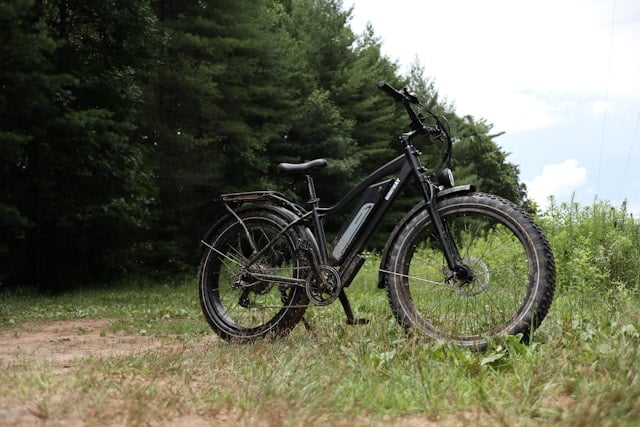
Yes, you can make an e-bike faster without breaking the law by optimizing the setup without bypassing speed limits. Simple changes like reducing weight, adjusting tire pressure, improving aerodynamics, and fine-tuning the gear ratio can all help increase speed legally.
If you’re looking for more speed without violating regulations, consider upgrading your battery (within the voltage limit), switching to a more efficient motor, or using a better controller that improves acceleration while staying within legal speed caps.
Some e-bikes also have settings that allow slight adjustments within legal boundaries. If you’re using your e-bike on private property or off-road trails, the rules may be more flexible, but always check your local laws before making any changes.
At the end of the day, there’s a balance between performance, safety, and legality. Making small, legal upgrades can give you a noticeable speed increase without putting you at risk of fines, confiscation, or warranty issues.
How Do I Know If My E-Bike Needs an Upgrade?
If your e-bike feels sluggish or struggles to keep up with your riding needs, it might be time for an upgrade. Here are some signs that your bike could use some improvements:
- You’ve hit the legal speed limit, but you want more acceleration.
- Your battery drains too quickly, leaving you with shorter rides.
- Your motor struggles on hills or against strong winds.
- Your e-bike feels too heavy, making it harder to reach higher speeds.
- You’re regularly riding with faster cyclists and can’t keep up.
If any of these sound familiar, a motor, battery, or controller upgrade might be worth considering—just make sure it aligns with local laws.
Conclusion
If you’ve been wondering how to make an electric bike go faster, now you have plenty of ways to do it. From upgrading your motor and battery to adjusting tire pressure and weight, there are both simple and advanced methods to increase speed.
Some tweaks, like removing the speed limiter, can get you into legal trouble, while others, like improving aerodynamics or modifying gear ratios, are safe and effective.
The best approach depends on your riding needs and where you’ll be using your bike. If you’re sticking to the streets, stay within legal limits and look for efficiency-focused upgrades.
If you’re riding on private property, you might have more freedom to experiment. Either way, keep safety in mind and enjoy the ride.
FAQs
Does pedaling make an e-bike go faster?
Yes, pedaling can help your e-bike go faster, especially if you’re using pedal assist mode (PAS). The more effort you put in, the less the motor has to work, which can slightly increase your speed and extend battery life.
Will switching to a bigger battery make my e-bike faster?
A bigger battery won’t directly increase speed, but a higher voltage battery can. For example, upgrading from a 36V to a 48V battery can give your motor more power, resulting in better acceleration and a higher top speed—assuming your motor and controller can handle it.
Do thinner tires make an e-bike faster?
Yes! Thinner, high-pressure road tires create less rolling resistance, allowing you to maintain higher speeds with less effort. If you’re riding on smooth pavement, switching from wide knobby tires to slick tires can make a noticeable difference.
Can I ride my modified e-bike on public roads?
It depends on your local laws. In most places, if your modifications push the e-bike beyond legal power and speed limits, it could be classified as a motor vehicle, meaning you might need a license, insurance, and registration. Always check your local regulations before making changes.
How can I increase my e-bike’s range while going faster?
To maintain speed without killing your battery too quickly, try these:
- Use a higher voltage battery that matches your motor.
- Pedal more to reduce motor strain.
- Keep your tires properly inflated for less resistance.
- Avoid excessive braking and accelerating, as that drains power faster.
- Ride in a lower-assist mode when speed isn’t necessary.
Is it safe to modify an e-bike for more speed?
If done correctly and within limits, yes. But increasing power beyond what your e-bike was designed for can overheat components, wear down your battery faster, or even damage your motor. If you decide to modify your bike, make sure your motor, controller, and battery can handle the changes.
Michael Josh is a hands-on e-bike tester and reviewer at BoltBikers, known for putting every model through real-world rides before sharing his thoughts. With a sharp eye for performance, comfort, and build quality, he helps the team choose which bikes are worth featuring. Backed by years of experience in tech and gear reviews, Michael brings trusted, honest insights to help readers find the right e-bike for their needs.

